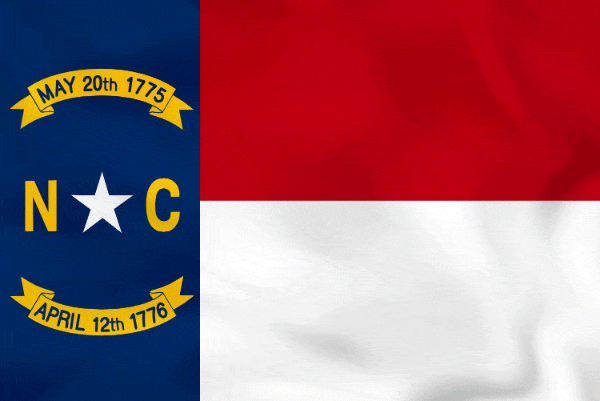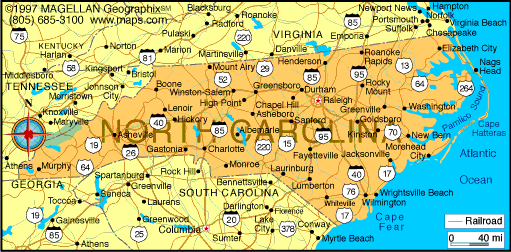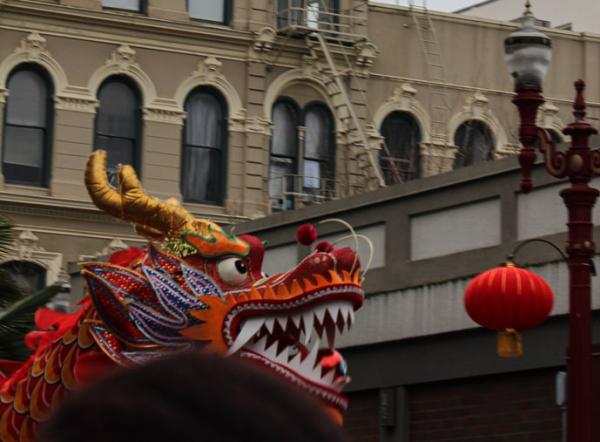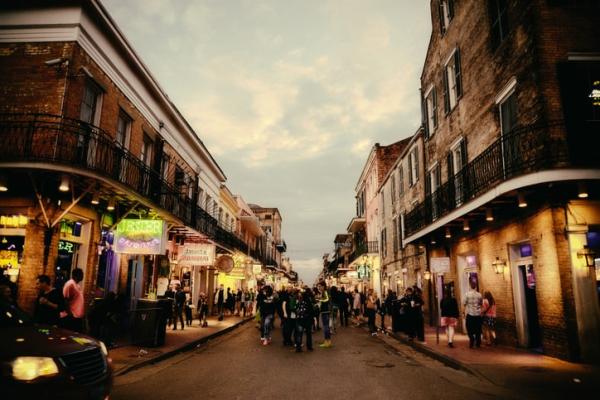North Carolina


North Carolina State Information
Official Name: North Carolina
Organized as a territory/republic: March 24, 1663
Entered Union (rank): November 21, 1789
Present constitution adopted: 1971
State abbreviation/Postal code: N.C./NC
State Area Codes: 252, 336, 704, 980, 828, 910, 919, 984
Fun Facts About North Carolina
Nickname: The Old North State, Tar Heel State
Origin of name: The state was named after King Charles I of England. The name "Carolina" is derived from the Latin form of Charles, which is "Carolus". The region was originally called "Carolana", or the land of Charles.
Motto: “Esse quam videri” (“To be rather than to seem”)
Slogan: “First in Flight”
Flower: Dogwood (1941)
Tree: Pine (1963)
Animal: Gray Squirrel (1969)
Bird: Cardinal (1943)
Fish: Channel Bass (red drum) (1971)
Vegetables: Sweet Potato (1995)
Gem: Emerald (1973)
Colors: Red and Blue (1945)
Song: “The Old North State” (1927)
Poem: “The Old North State” by Leonora Monteiro Martin (1957)
Fossil: Megalodon Teeth (2013)
Dinosaur: Carcharodon Megalodon (2013)
Cookie: Moravian Cookie (Proposed In 2023)
Insect: Western Honey Bee (1973)
Government
Governor: Roy Cooper, Democrat (to 2024)
Lieut. Governor: Mark Robinson, Republican (to 2024)
Secretary of State: Elaine Marshall, Democrat (to 2024)
General Treasurer: Dale R. Folwell (to 2024)
Atty. General: Josh Stein (to 2024)
Senators: Ted Budd, R (to 2024); Thom Tillis, R (to 2024).
Historical biographies of Congressional members
State website: https://www.nc.gov/
Population
Residents: North Carolinians
Resident population: 10,710,533 (10th Largest State, 2023)
10 largest cities (Latest statistics year): Charlotte, 885,708; Raleigh, 474,069; Greensboro, 299,946; Durham, 294,987; Winston-Salem, 247,945; Fayetteville, 224,788; Cary, 178,915; Wilmington, 123,744; High Point, 112,791; Greenville, 95,394.
Race/Ethnicity: White (70%); Black (22.3%); Hispanic (10.2%); Asian (3.4%); American Indian and Alaska Native (1.6%); Native Hawaiian and Other Pacific Islander (0.1%); Two or More Races (2.5%).
Religion: Evangelical Protestant (35%), Mainline Protestant; Black Protestant (12%), Catholic (9%), Morman (1%), Orthodox Christian (1%), Jehovah’s Witness (1%), Jewish (1%), Muslim (<1%), Buddhist (<1%), Hindu (<1%) Other World Religions (1%).
Sex: Female (51.1%); Male (48.9%)
Age: Under 18 (21.8%); 18-64 (55.6%); 65 and over (17%). Median Age: 38.9.
Economy
GDP: 559.51 billion dollars (10th in the U.S., 2023)
Unemployment: 3.4% (2023)
Geography
Land area: 53,819 sq mi. (139,390 sq km)
Geographic Center: In Chatham Co., 10 mi. NW of Sanford
Number of Counties: 100
Largest county by population and area: Wake County, 1,150,722 (2021); Robeson County, 947.3 sq mi.
State parks/recreation areas: 29
North Carolina, located in the southeastern region of the United States, is a diverse and captivating state, offering a wealth of natural beauty, rich history, and vibrant culture. North Carolina boasts a range of breathtaking landscapes, from the stunning Appalachian Mountains in the west to the picturesque Outer Banks along the Atlantic coast. Its bustling cities, including Charlotte and Raleigh, blend urban sophistication with Southern charm, while the charming small towns showcase a slower pace of life.
The state is renowned for its barbecue, sweet tea, and basketball enthusiasm, as well as being home to prestigious universities and a thriving arts scene. With its blend of southern hospitality, scenic wonders, and a tapestry of experiences, North Carolina captivates visitors and residents alike.
North Carolina Geography
The state of North Carolina is 560 miles wide and has a widely diverse geography. The state is bordered on the east by the Atlantic Ocean and divided into three physiographic regions: the Coastal Plain, Piedmont, and the Appalachian Mountains. There are several state parks across the state of North Carolina that are recognized for their scenic beauty and history.
The Coastal Plain, bordered by the Atlantic Ocean, includes 300 beaches, swamps, dunes, and marshes. It’s made up of the Tidewater and the Outer Banks. The area is also known for several plant species, including two carnivorous plants, the Pitcher Plant and the Venus Fly Trap. There are three capes along the coast: Cape Hatteras, Cape Lookout, and Cape Fear.
Cape Fear is a captivating region renowned for its scenic beauty, rich historical significance, and connection to cinema. The area comes from the treacherous Cape Fear River, which flows into the Atlantic Ocean and has long been a focal point for maritime activities. The coast of North Carolina has seen so many shipwrecks that it is considered the “Graveyard of the Atlantic Ocean.”
As the state extends out west, 140 miles, the next geographical region is Piedmont, which comprises hilly, rolling lands with various rivers and lakes. The region has several hardwood swamp forests filled with tree species such as ash, swamp chestnut oak, and sycamores. Dams on the Catawba and Yadkin Rivers supply hydroelectric power to the region. The Catawba River area is one of the most densely populated areas in the state. The Piedmont Triad comprises the three largest cities in the region: Greensboro, Winston-Salem, and High Point.
The next region is the mountains, which include several mountain ranges that are part of the Appalachian Mountain Trail, including the Great Smoky Mountains and Unaka Mountains. The Black Mountains of Yancey County have six of the highest mountain peaks in the eastern US, with Mount Mitchell topping the list at 6,684 feet. Mount Mitchell is the highest elevation in the southern part of the Appalachian Trail.
North Carolina People and Population
North Carolina, with a population of 10,439,388, as recorded in the 2020 Census, has experienced a remarkable surge in population growth over the past few years, making it one of the fastest-growing states in the country. The state of North Carolina’s demographics showcase a diverse ethnic composition, with white people accounting for 63.9% of the population. African Americans make up 21.8% of North Carolina's population. The state also has a 10.7% Hispanic or Latino population. North Carolina has witnessed a notable influx of immigrants, constituting 8% of the state's population as of 2020.[1]
The state also has a Native American population of 2.5%. It is home to eight major state-recognized tribal communities: the Coharie, the Eastern Band of Cherokee Indians, the Haliwa-Saponi, the Lumbee Tribe of North Carolina, the Meherrin, the Sappony, the Occaneechi Band of Saponi Nation, and the Waccamaw Siouan.[2]
English is the primary language, with Southern American and Appalachian dialects. Spanish is the state’s second major language.
North Carolina Government
The state government of North Carolina is divided into three separate branches: the executive, legislative, and judicial. The Governor heads the executive branch, currently Roy Cooper (D), who serves as the state's chief executive officer. The Governor implements laws, manages state agencies, and represents the state's interests. Mark Robinson (Republican) is the Lieutenant Governor, the second-highest executive officer.
The legislative branch is also called the North Carolina General Assembly, comprising a House of Representatives with 120 members and the Senate with 50 members. The General Assembly makes and passes laws for the state. The number of representatives and senators is determined by population and district. The Lieutenant Governor runs the General Assembly.
In the judicial branch, the highest court is the Supreme Court of North Carolina, which serves as the ultimate authority on legal matters within the state. The Governor appoints judges to fill vacancies on the court, and they later stand for election to keep their positions.
Local governments are broken down into 552 municipalities in North Carolina and 100 counties. Local governments have a general purpose, and there’s no difference between a town or city in governing practice. State employees form an essential workforce across various agencies, departments, and institutions, diligently striving to uphold the smooth operation of government services and programs.
In terms of elections, North Carolina has seen a competitive political landscape. Historically, the state has leaned towards supporting Republican candidates in presidential elections, while much of the state votes Democratic in state elections. According to North Carolina’s Demography, in October 2022, the state had 7.4 million registered voters. Voter affiliation is almost evenly split between three groups, with 34% registered as Democrats, 30% as Republicans, and 36% unaffiliated. Additionally, 7% were registered with another party.[3]
North Carolina Economy
Many industries and abundant natural resources characterize North Carolina's economy. The state's major sectors include manufacturing, agriculture, technology, finance, healthcare, and tourism.
Manufacturing plays a vital role in North Carolina, with the aerospace and defense, automotive, biotechnology, textiles, and furniture industries being significant contributors. Notable companies like Boeing, Caterpillar, and Goodyear are in the state, driving economic growth and job creation.
The agricultural sector is a firm but small part of the state’s economy. Most of the farms in the state are owned by families. North Carolina is the leading grower of sweet potatoes, tobacco, beans, poultry, and pork.
North Carolina has emerged as a technology and research hub, particularly in the Research Triangle Park area encompassing Raleigh, Durham, and Chapel Hill. This region is home to many high-tech companies, research institutions, and startups, fostering innovation in biotechnology, pharmaceuticals, software development, and telecommunications, and promises to continue to be a growing sector in the state.
The financial sector flourishes in Charlotte, North Carolina's largest city, which has become a major financial center in the southeastern United States. Several prominent banks, financial service centers, and companies have headquarters or significant operations in the city.
Tourism significantly contributes to the state's economy, drawing visitors to the beaches in the eastern part of the state and to small towns like Albemarle that offer outdoor and quiet living near the busier areas. Located near Albemarle, Morrow Mountain State Park offers picturesque views of the Uwharrie Mountains. Visitors can hike to the summit of Morrow Mountain, explore scenic trails, enjoy boating and fishing on Lake Tillery, or discover the park's rich history and Native American heritage. At the same time, western North Carolina has the scenic Blue Ridge Mountains and other Appalachian mountain ranges. The state is rich with colonial and civil war history, which attracts history buffs from all over the country.
The state also suffers from economic disparities regarding income and overall quality of life. Metropolitan areas, including the Piedmont Triad, Research Triangle, and greater Charlotte area, lean towards having average to higher-than-average incomes. These areas also have great access to amenities and education, such as NC State University in Raleigh. However, in the state’s rural regions, many areas have well below-average incomes and little access to newer job opportunities, services, and education, creating significant disparities in the quality of the state resident’s life. There are economic disparities within the state regarding average income and quality of life. The state is trying to address these disparities and promote economic development in rural communities.[4]
North Carolina Interesting Facts
North Carolina's cultural life is a vibrant tapestry celebrating its diverse heritage, artistic expression, and culinary delights. Its cultural life blends traditional Southern influences, Native American traditions, and diverse immigrant communities. The arts, music, literature, and cuisine all contribute to the cultural fabric of North Carolina.
Feel the Music
North Carolina has a rich traditional music scene, especially in the Appalachian region, where bluegrass, folk, and old-time music have deep roots that have shaped the state’s musical heritage and are known for musicians such as the banjo player, Earl Scruggs, and Doc Watson. The annual MerleFest in Wilkesboro showcases renowned musicians and celebrates the state's folk and bluegrass traditions.
Dabble in the Arts
North Carolina also has a thriving visual arts community. The North Carolina Museum of Art in Raleigh houses an impressive collection spanning various periods and genres, while the Mint Museum in Charlotte focuses on American art and crafts. Asheville, known for its vibrant arts scene, is home to numerous galleries, studios, and craft shops, attracting artists and art enthusiasts alike.
A Place at the Table
Culinary traditions hold a special place in North Carolina's cultural fabric. The state is renowned for its distinctive barbecue styles, creating regional rivalries within and outside the state. The state is known for having prominent variations between Eastern-style vinegar-based sauce and Lexington-style tomato-based sauce. Along the coast, seafood, particularly shrimp and oysters, is celebrated along the coastal areas, while the Piedmont region offers delectable Southern farm-to-table cuisine.
North Carolina History
North Carolina has a rich history, from ancient to modern times. Most of the land was underwater at one time, and great megalodon sharks and other prehistoric creatures roamed the once ocean-covered lands. On land, fossils have shown that it was also once the home of wooly mammoths and mastodons.
Pre-Colonial History
Before the European colonists, the land that is now North Carolina was populated with several Native American tribes. Native peoples practiced a combination of hunting and agriculture, including growing corn. They developed strong and prosperous cultural traditions, languages, and art as these communities grew more permanent. Soon, large native towns grew stronger and more extensive, were built beside rivers and streams, and included defensive structures from rival tribes. These tribes included the Cherokee, the Catawba, the Tuscarora, the Croatoan, and many others. The largest of these tribes was the Cherokee.
Colonial History
The first Europeans arrived in North Carolina in 1524, Giovanni da Verrazano, a Spanish explorer, was the first to map out the coastline. Soon other explorers, such as Hernando de Soto, would arrive in 1567, looking for gold.
In 1584, English settlers established the first European colony in North America. Sir sponsored Roanoke Colony. Walter Raleigh. Because of hardships, many of the first colonists returned to England, and a new colony was eventually started at Roanoke. Virginia Dare was born on August 18, 1587, and was the first child of English settlers on North American soil. Some colonists soon after returned to England to collect and return supplies. However, when they returned, they found the colony abandoned, with little evidence of the reason. Some suggest trouble with the local Croatoan tribe, starvation, and other otherworldly possibilities. The settlement became known as “The Lost Colony” and continues to boggle the minds of historians.
From 1711 to 1713, Native Americans and European settlers entered a war with the local Tuscarora Tribe. The English settlers were accused of encroaching on Tuscarora farmlands and hunting grounds. On September 22, 1711, the tribe attacked the colonists who lived near New Bern, killing men, women, and children. Plundered and set fire to the town. They killed over 130 people in the attack. The colonists sought help from South Carolina, the Cherokee, and other allied tribes; eventually, the Tuscarora were defeated. There would be several other wars and violent outbreaks between the settlers and the Native Americans in the following years as the English settlers continued to expand. This includes the French and Indian War fought between England and France along the frontier of North America. Gradually, the tribes were forced further west by scrupulous deals, the spread of diseases, and the competition for resources.
Along with frequent fighting with the Native Americans, the colony experiences pirate raids from infamous figures such as Blackbeard and Stede Bonnet along the coast.
Initially, North and South Carolina were a single colony of Carolina. However, there was a great distance between the settlements, and both areas acted independently. In 1712, North Carolina split from South Carolina and officially became its own English Royal Colony in 1729, becoming one of the original Thirteen Colonies.
In the 1770s, tensions between the Thirteen Colonies and Great Britain grew stronger, and soon there was a growing idea of separating from Great Britain. On April 12, 1776, North Carolina adopted the Halifax Resolves and was the first of the colonies to formally demand independence from Great Britain at the start of the American Revolution. In 1789, North Carolina became the 12th state to ratify the United States Constitution.
Pre-Civil War History
After the American Revolution, the country began its Antebellum period between the 1830s and the time of the Civil War, which included significant growth and invention. Inventions such as the railroad and steamboat made travel and trade faster and easier. The telegraph was invented, and soon even information could move at greater speeds than ever before. As more people explored the West, those new inventions and technological improvements did not as easily make their way into the Appalachian areas because of their difficult terrain. This gave North Carolina a bit of a backwater and poor image to outsiders and was the beginning of the seeds for an economic and cultural difference between eastern and western North Carolina.
Slavery was another significant part of the Antebellum period. Like other southern states, North Carolinian plantations relied on the labor of enslaved people to work on their cash crops, like cotton, tobacco, and rice, which were sold for profit. Most enslaved people were in the eastern part of the state, where the larger plantations were near riverways and coastal ports. Because of poor transportation and less lucrative lifestyles, enslaved people were less common in the West. However, North Carolina still had many enslaved people, with one out of every three North Carolinians being an enslaved black person.[5]
In the events and political tensions leading up to the American Civil War, on May 20, 1861, North Carolina declared its secession from the Union. She became the 10th of 11 states to join the Confederate States of America. The North Carolina coast became an important site during the Civil War, with both sides wanting to control the waters and port. The largest battle fought in North Carolina was the Battle of Bentonville, which occurred in Johnston County on March 19–21, 1865. The battle considered what remained of the Confederate army, led by Confederate General Joseph E. Johnston. Union General William T. Sherman defeated him in what would become the last large-scale battle of the Civil War. The war ended a month later, on April 9, 1865. North Carolina was readmitted into the Union in 1868.
Post-Civil War History
After the Civil War, North Carolina faced challenges during Reconstruction. It ratified the Thirteenth Amendment, granting freedom to enslaved individuals, and African Americans acquired voting rights. However, resistance from white supremacists, economic struggles, and political shifts marked this period. Industrialization reshaped the economy, while racial tensions and the rise of the Ku Klux Klan and Jim Crow laws perpetuated segregation and disenfranchisement. Overcoming the legacy of slavery and racism would require continued efforts for years and even into the modern era.
During the 19th century, North Carolina transitioned from an agrarian society to a more industrialized state. The growth of textiles, tobacco, and furniture manufacturing industries transformed the state's economy. Textile mills emerged in towns and cities, attracting workers and contributing to urbanization. The rise of tobacco production solidified North Carolina's status as a leading producer.
On December 17, 1903, it was in Kitty Hawk, in North Carolina’s Outer Banks, that Orville and Wilbur Wright made the first controlled, sustained flight of an aircraft. This led to the slogan “First in Flight,” common on modern North Carolina license plates.
Political changes also occurred during this period. The Democratic Party regained control in the late 19th century, and the state shifted towards conservative policies.
This era saw the rise of influential political figures like Furnifold M. Simmons, a U.S. Senator from 1901 to 1913, who was a staunch segregationist and white supremacist and a leading perpetrator in the Wilmington Insurrection of 1898, as well as Charles B. Aycock, the 50th governor of the state from 1901 to 1905, who was also a white supremacist and segregationist. However, Aycock was known as a strong supporter of promoting better education in public schools for both white and Black children.
Modern History
At the beginning of the 20th century, because of the racist policies and cultural norms in the South after the reconstruction, many African Americans moved away from North Carolina for better opportunities in the Great Migration. This caused a lot of demographic and labor changes in the state.
As the nation moved into the 20th century, North Carolina faced the challenges and effects of World War I. The state contributed soldiers and resources to the war effort, experiencing the economic and social changes accompanying wartime mobilization.
In 1916, the Cheoah Dam project began on the Little Tennessee River. It is a hydroelectric complex in Graham and Swain counties. It was completed in 1919 and created the Cheoah Reservoir, which covered 644 acres. When completed, the 225-foot dam was the world's highest overflow dam, with the largest turbines in the world.
By the 1930s and the Great Depression, the state was struggling. The state could take advantage of New Deal programs put forth by President Franklin D. Roosevelt for cotton and tobacco. Again in World War II, North Carolinians mobilized for war, sent off troops, and gathered resources for the war effort on two fronts. Military bases and training facilities were established across the state, such as Camp Lejeune and Fort Bragg, which contributed to the training and deployment of troops. The state's industrial capacity expanded, with factories converting to war production to support the military.
After the war, North Carolina saw its economy grow rapidly as cities like Charlotte, Raleigh, and Durham’s populations and industries grew. This led to the development of urban areas such as the Triad and Research Triangle Park, which was established in 1959 and serves as the largest research park in the United States.
In the 1960s, the political atmosphere changed again as events like the Greensboro sit-ins and other Civil Rights Movements aimed to bring equality to African Americans and minorities.
In the 1970s, the state’s population grew in its metropolitan areas thanks to the technology and finance industry, education, and college opportunities. North Carolina has top schools, such as NC State in Raleigh, Duke University in Durham, and the University of North Carolina in Chapel Hill.
Today, North Carolina continues to be a growing state in the United States. The state has begun a significant shift from tobacco and textiles towards higher education, national baking, and technology. It continues to be a dynamic and evolving part of the United States.
People Also Ask…
If you are interested in more information about the state of North Carolina, then keep reading — we have compiled answers to the most common FAQs below. Plus, test your newfound state knowledge by taking our quiz on American Revolution!
Is North Carolina a Good Place To Live In?
North Carolina, the 10th fastest-growing state in the U.S., is one of the top states currently attracting new businesses and investments. Research Triangle Park is a constantly growing and advancing area with good-paying jobs, technology, and higher education opportunities, such as NC State and Duke University. The cost of living in North Carolina is low. It is regarded as a very affordable place with good weather and the potential to attract people from more expensive states such as New York and California.
What Is North Carolina Most Known For?
North Carolina is known for its rich history in aviation, traditional music with blues and folk, barbeque sauce, beautiful coastline, dense forest, and massive mountain ranges such as the Blue Ridge Mountains and other parts of the Appalachian Trail.
What Is It Like To Live in North Carolina?
North Carolina has a diverse geography, mild winters, and a booming finance and technology market. The people who live there are praised for their kindness and hospitality. It has a better healthcare system than much of the South but still lags behind neighboring states such as Virginia. It has become one of the most popular destinations in the country for growing families and young professionals to make their home.
Famous North Carolina natives and residents:
- Virginia Dare first person born in America to English parents;
- Elizabeth Dole government official;
- Ava Gardner actress;
- Billy Graham evangelist;
- O. Henry writer;
- Andrew Johnson president;
- Sugar Ray Leonard boxer;
- Dolley Madison first lady;
- Thelonious Monk pianist;
- Edward R. Murrow commentator and government official;
- Floyd Patterson boxer;
- Richard Petty auto racer;
- James K. Polk president;
- Thomas Wolfe novelist.








